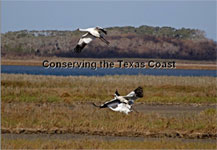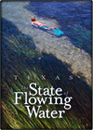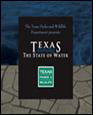Media Room
Ready-to-use presentations, podcasts, and images; plus video synopses and transcripts.
Permission is granted to use contents on this cd rom for education purposes.
 Presentations Presentations
Podcasts
Image Gallery
Video Synopses and Transcripts
 Texas the State of Water, Vol IV - The State of Flowing Water Texas the State of Water, Vol IV - The State of Flowing Water
Narrated by Lydia Saldaña
Run time: 57:00
Transcript
This hour-long documentary examines the threats facing Texas’ flowing water and what can be done to protect our most precious natural resource.
- Segment 1: Keeping the Flow Examines the importance of water flowing in creeks and streams as an integral part of sustaining healthy rivers as well as recharge underground aquifers. The Texas Instream Flow Program and the creation of Paddling Trails is also featured.
- Segment 2: Refuge from a Reservoir Looks at the efforts of residents of East Texas to help establish a National Wildlife Refuge where the City of Dallas wants to build another reservoir. It also looks at efforts in Dallas to conserve water as well as alternatives to building another reservoir.
- Segment 3: Reservoir on the Side Profiles three projects that reflect the growing trend of building reservoirs off the main channel of a river to lessen the impacts to the natural hydrology of rivers.
- Segment 4: Lifeline of the Bays Looks at the implementation of legislation to have local stakeholders cooperatively determine how much fresh water needs to be reserved for each of the Texas river and bay systems.
- Segment 5: Water Futures Examines how population growth and climate change predictions and may impact Texas.
- Segment 6: Living in the Balance Examines how sustainable building practices can reduce water and energy needs in the future.
 Texas the State of Water, Vol. III - The State of Springs Texas the State of Water, Vol. III - The State of Springs
Narrated by Walter Cronkite
Run time: 58:00
Transcript
This hour-long documentary examines the alarming decline of Texas’ natural springs and addresses the current issues that directly impact spring flow and what can be done to save these vital natural resources. Segments include: Lost Springs; Threatened Springs; Found Springs; Springs for Sale; Springs for the Future; Links to Your Lifestyle.
- Segment 1- Lost Springs- Examines the importance of springs to Native Americans and early settlers with visits to Big Spring, Comanche Springs in Ft. Stockton and San Pedro Springs near Carizo Springs.
- Segment 2- Threatened Springs- Looks at the importance of San Marcos and Comal Springs to river flows and plans of the Edwards Aquifer Authority to raise pumping caps. It profiles opposition by the Save Our Springs coalition to development of an office complex in Austin. It also features efforts by the City of Del Rio to protect San Felipe Springs with a Watershed Management Plan. We also visit a landowner in Blanco whose spring is threatened by developers building homes and a golf course.
- Segment 3- Found Springs- Examines how efforts to control brush on private lands may yield more water to aquifers and streams. We visit a the Selah preserve near Johnson City, the Powell Ranch near San Angelo and the Leon River restoration Project near Gatesville.
- Segment 4- Springs for Sale?- The Water Marketers- Examines the Rule of Capture and how private companies and individuals are buying up land and water rights to sell groundwater to the highest bidder. Billionaire T. Boone Picket’s Mesa Water project is profiled, along with the struggles of a small Groundwater Conservation District in Kinney County.
- Segment 5- Springs for the Future- Examine various strategies to acquire and manage property to protect springs and aquifer recharge. We visit Government Canyon State Natural Area where a coalition of entities banded together to conserve land over Edwards Aquifer, protecting the watershed for San Antonio. We also travel to West Texas where Independence Creek feeds the Pecos River and Dolan Falls Preserve that feeds the Devils River. Finally we meet the Storm family that has negotiated a conservation easement to keep a family ranch intact and protect a vital watershed south of Dripping Springs.
- Segment 6- Links to your Lifestyle- profiles various water conservation strategies that every homeowner can implement to reduce their use of water and save money at the same time. We see how using drought tolerant native plants, reduces water and fertilizer use and how new appliances and fixtures inside the home reduce water waste.
 Texas the State of Water, Vol. II – Finding a Balance Texas the State of Water, Vol. II – Finding a Balance
Narrated by Walter Cronkite
Run time: 56:46
Transcript
"Finding a Balance" explores how the growing demand for water will grow dramatically over years to come, and weighs the impact that growth will have on the state. The documentary shows how the steps we take, or don’t take, will impact Texas and its people, wildlife and economic vitality for future generations. Segments include: Tomorrow's Task Today - A water law primer; Whiskey's for drinkin' and water is for fightin'-Water in the courts; The Sacred River – Keeping the Neches Natural; The Latest Liquid Gold; The Phoenix Flow-Freshwater Inflows; Links to Your Lifestyle.
- Segment 1- Tomorrow’s Task Today explains the difference between surface water rights and groundwater rights and delineates the various state and local agencies that have jurisdiction over them.
- Segment 2- “Whiskey is for drinkin’ and water is for fightin’” profiles recent court cases and conflicts over groundwater and surface water. Cases include: the Sierra Club vs. USFW which resulted in the creation of the Edwards Aquifer Authority, the suit between the San Antonio Water System and the Living Waters Catfish Farm, the denial of the San Marcos River Foundation’s instream flow permit by the Texas Commission on Environmental Quality and subsequent suit.
- Segment 3- Keeping the Neches Natural looks at efforts to designate the upper part of the Neches River as a Scenic River, the contributions reservoirs have made and the fight of a landowner to stop a reservoir from taking his family’s property.
- Segment 4- The Latest Liquid Gold looks at how water has become a commodity. Profiles why the Lower Colorado River Authority purchased water rights to increase the amount of water they control. Also profiles an off channel reservoir project between the San Antonio Water System and the Guadalupe-Blanco River Authority and the concerns of its impacts on the bays. (NOTE- the SAWS withdrew from the project with GBRA).
- Segment 5- The Phoenix Flow- Freshwater Inflows to Bays examines how freshwater inflows impact ecological and economic future of bays, past TPWD studies and present studies by Texas A & M. Also looks at the establishment of the Environmental Flows Study Commission, the rise of ecotourism and the interest in whooping cranes.
-
Segment 6 – The Links of your Lifestyle profiles the Water Conservation Task Force and the successes of water conservation in San Antonio and the importance of good range management on private lands. Also profiles a housing development in San Antonio designed with water conservation in mind and volunteer opportunities with Texas Watch to monitor local streams and rivers.
 Texas the State of Water, Vol. I Texas the State of Water, Vol. I
Narrated by Ray Benson
Run time: 58:00
Transcript
Our first documentary examines in depth the present state of water resources in our fast growing state. By looking at local issues all around the state, from the parched deserts of West Texas to the water rich swamps of East Texas, this program hopes to raise awareness of the variety of complex demands being made on the aquifers, rivers and bays of Texas. This program will also show how these seemingly separate elements actually all work together as one large interconnected ecosystem, and how each plays a vital role in the overall ecological health of our state and the states economy.
- Segment 1: West Texas The Rio Grande is a river in peril. The problems begin well before the river reaches El Paso, and continue to the river’s end. How is this desert city meeting its water needs, and what are the effects downstream?
- Segment 2: Caddo Lake East Texas is water rich, at least when compared with much of the state. Despite the abundance of water, there’s a fight brewing over water rights, with scenic Caddo Lake as the focal point.
- Segment 3: Down in The Valley As the once might Rio Grande makes its way to the sea, its flow is constantly being reduced by forces both natural and man-made. Farmers and cities in the Valley are struggling to save the river, and their way of life.
- Segment 4: The Panhandle Selling ground water and then transporting it across the state is a reality in the Panhandle. But landowners who don’t want to sell their water rights are pitted against those that do. All the while the aquifer level continues to drop.
- Segment 5: The Colorado & Trinity The Colorado and Trinity are very different rivers; one rural, the other urban. Both are vital to their regions of the state, and both face a different set of problems. One thing they do have in common is their impact on the bays and estuaries at rivers end.
- Segment 6: End of the Line? The Rio Grande is emblematic of water issues facing Texas today. Problems on both sides of the border have reduced this once mighty river to a trickle, stopping the Rio Grande short of the Gulf of Mexico.
Texas Water Stories
A compilation of short films exploring the various dynamics of water issues across the state. Titles include:
Save Water for Wildlife
Run time: 8:22 Transcript
Growing human populations will continue to alter the quantity and quality of freshwater. Even though our water systems are already stressed, there’s great potential for restoring and sustaining water resources for both people and wildlife if individuals and communities can simply conserve water now.
The Rio Grande/Down But Not Out
Runtime 8:34 Transcript
We follow a group of 8th graders on a rafting trip down the Rio Grande, along the way they learn about the various pressures on the Rio Grande; water and farming, invasive trees/shrubs, lack of aquatic diversity.
Building the Canyon
Runtime 10:17 Transcript
Government Canyon State Natural Area has grown out of a unique partnership of groups who have come together to preserve a precious resource. The more than 8,000 acre area of pristine Hill Country land helps protect the aquifer below it, and that makes it all the more important to nearby San Antonio.
The Costs of Water
Runtime 12:24 Transcript
Brief history of water regulation in Texas focusing on the Lower Colorado River, includes explanations of "first in time first in right" and "rule of capture."
Dealing with Drought
Runtime 10:26 Transcript
As the population of Texas grows, many cities are searching for new sources of clean water. See how the city of Corpus Christi is working to meets its needs both now and for the future.
Last of the Bayous
Runtime 7:54 Transcript
Clear Creek is a slow-moving creek, called a bayou, but it's very different from the other bayous around Houston. Although houses and subdivisions populate its banks, Clear Creek still supports an abundance of birds, fish & wildlife. But things are changing along the creek, and for much of the wildlife that calls this bayou home ... time may be running out.
The Dessert Oasis
Runtime 10:32
San Solomon Spring is an oasis in the Chihuahuan Desert of West Texas. Balmorhea State Park is built around this spring, and area farmers also depend on the spring to irrigate their crops. In addition, two endangered species of fish, the Comanche Springs Pupfish and the Pecos Gambusia (or mosquito fish) would no longer exist without the spring water. This story follows a remarkable cooperative effort between area landowners and government agencies to save the life-giving springs. By creating a cienega, or desert wetland, they have vastly improved the long-term chances of survival for both fish and farming.
Clean Creek or Polluted Creek
Runtime 2:54 Transcript
The Kills & Spills team headed by Dave Buzan has a program that allows kids to test for themselves to determine if a river or creek is polluted. This is accomplished by checking to see what kind of insects are found in the area. Certain insects indicate clean water, while others indicate the presence of pollution.
The Value of Wetlands
Runtime 4:02
Many people still think of wetlands as wasteland. We find out how important these areas really are to both humans and animals.
Exploring Texas: Monitoring and Caring for our Water
Runtime 4:04
First episode of a new series designed to show teachers how to incorporate environmental and cultural studies into their curriculum. This episode focuses on water quality and wetlands, and how students can do scientific lab and field work while developing their observation, sequencing and classification skills. Includes three video segments: “Water Quality in Texas,” “Texas Wetlands: A Learning Adventure,” and “Creek Bugs.”
Texas Wetlands: A Learning Adventure
Runtime 10:19
Recruitment video for the Adopt-a-Wetland program in which children adopt wetlands near their home for study and preservation.
Brazos River Clean Up
Runtime 3:13
Once a year, volunteer groups throughout Texas participate in the annual "Trash Bash,” an effort to get people involved in cleaning up their local waterways. One such group is the Brazos River Preservation Society of Houston. About 125 of its members gathered along the Brazos River near Highway 59 to clean up an area where thousands of tires and hundreds of rusted automobiles choke the waterway. A couple days before the Trash Bash, some of the members of the BRPS took us on a ride down the river to show how bad the problem has become.
[top]
|
